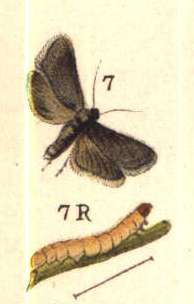Grapholita
| Grapholita | |
|---|---|

| |
| Adult (above) and caterpillar (below) of the plum fruit moth (G. funebrana) from the Nordisk familjebok. Scale is 1 cm. | |
| Scientific classification | |
| Domain: | Eukaryota |
| Kingdom: | Animalia |
| Phylum: | Arthropoda |
| Class: | Insecta |
| Order: | Lepidoptera |
| Family: | Tortricidae |
| Subfamily: | Olethreutinae |
| Tribe: | Grapholitini |
| Genus: | Grapholita Treitschke, 1829 |
| Type species | |
| "Pyralis dorsana" sensu Treitschke, 1829 (see text)
| |
| Diversity | |
| 126 species | |
| Synonyms | |
|
Numerous, see text | |
Grapholita is a large genus of tortrix moths (family Tortricidae). It belongs to subfamily Olethreutinae, and therein to the tribe Grapholitini, of which it is the type genus.[1]
Taxonomy and systematics
Georg Friedrich Treitschke established Grapholita in 1829 – in the 7th volume of Schmetterlinge von Europa, with a type species he claimed to be "Pyralis dorsana", a taxon established by Johan Christian Fabricius in his 1775 Systema Entomologiae. But Treitschke was misled by Jacob Hübner's misidentification of Fabricius' moth.[2]
The actual P. dorsana is today known as Dichrorampha petiverella, as it had already been described by Carl Linnaeus in his 1758 edition of Systema Naturae as Phalaena (Tinea) petiverella. The "Pyralis dorsana" of Hübner and Treitschke was subsequently identified as the species described as Tortrix lunulana by Michael Denis and Ignaz Schiffermüller in 1775, which thus is today Grapholita lunulana.[3]
Species
Grapholita currently has 126 recognised species, though the genus' distinctness from and delimitation against Cydia is in need of further study:[4]
Synonyms
Obsolete scientific names (junior synonyms and others) of Grapholita are:[6]
|
|
Footnotes
- ^ Baixeras et al. (2009a)
- ^ Treitschke, (1829), Baixeras et al. (2009a)
- ^ Baixeras et al. (2009a,c)
- ^ Baixeras et al. (2009b)
- ^ a b c d e f g h i j k l m n o p q r s t u v w x y Sometimes placed in Cydia: see e.g. references in Savela (2005a)
- ^ Baixeras et al. (2009a), and see references in Savela (2005b)
References
- Baixeras, J.; Brown, J. W. & Gilligan, T. M. (2009a): Online World Catalogue of the Tortricidae – Genus Grapholita account. Version 1.3.1. Retrieved 20 January 2009.
- Baixeras, J.; Brown, J. W. & Gilligan, T. M. (2009b): Online World Catalogue of the Tortricidae – Grapholita species list. Version 1.3.1. Retrieved 20 January 2009.
- Baixeras, J.; Brown, J. W. & Gilligan, T. M. (2009c): Online World Catalogue of the Tortricidae – Dichrorampha petiverella. Version 1.3.1. Retrieved 19 April 2009.
- Savela, Markku (2005a): Markku Savela's Lepidoptera and Some Other Life Forms – Cydia. Version of 13 September 2005. Retrieved 19 April 2010.
- Savela, Markku (2005b): Markku Savela's Lepidoptera and Some Other Life Forms – Grapholita. Version of 13 September 2005. Retrieved 19 April 2010.
- Treitschke, Georg Friedrich (1829): [Genus Grapholita]. In: Die Schmetterlinge von Europa (Siebenter Band. Zünsler. G[enera] Herminia-Ennychia.): 232. Gerhard Fleischer, Leipzig. Fulltext at the Internet Archive
